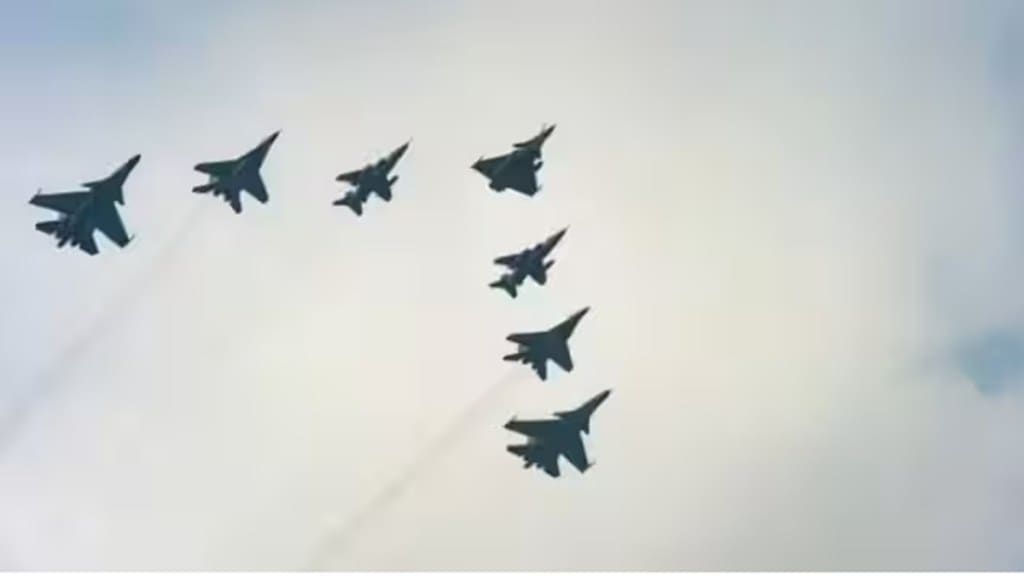For the last time MiG-21 fighter jets of the Indian Air Force will fly in India as well as globally in any air-display later this week as part of 91st anniversary parade.
Addressing the annual press meet ahead of the Air Force Day on Oct 8, Indian Air Force Chief Air Chief Marshal VR Chaudhari said: “These MiG21s will be replaced by indigenous Light Combat Aircraft (LCA) `Tejas’.”
The air chief said that besides the earlier contract for 83 LCA-Mk1A, order for 97 more Light Combat Aircraft (LCA) Tejas Mark-1A fighter jets will be placed later this year. “We will sign with Hindustan Aeronautics Limited (HAL). They may further allocate work to the private sector.” The number of 97 is not to reduce the existing projection of the Tejas Mark
Air Display over Sangam
On Oct 8 over Sangam in Prayagraj three MiG 21s will fly for the last time in the Indian skies.
Entire fleet grounded
As previously reported, the entire fleet of MiG-21 fighter jets, which have been in active service for over five decades, has been grounded following an incident in Rajasthan in May.
The process of gradually retiring these Russian-made jets from the air force had already commenced. The MiG-21 was introduced into the Indian Air Force (IAF) in the 1960s. The frequent crash incidents involving these jets had raised serious concerns.
According to officials from the Defence Ministry, currently, only three operational MiG-21 squadrons exist within the IAF, and all of them are scheduled to be phased out by early 2025.
History, accidents, and their retirement plans
The MiG-21s are among the six fighter jets currently in service with the Indian Air Force (IAF) and have long served as a pillar of the service.
These aircraft are single-engine, single-seater multi-role fighter and ground attack planes. Initially designed as interceptor aircraft in 1963, they underwent numerous upgrades over the following decades to perform various fighter aircraft roles, including ground attack.
Since then, India has acquired over 700 MiG-21 aircraft of different versions, such as the Type-77, Type-96, and the BIS. The most recent variant is the MiG-21 Bison, featuring advanced missiles, radars, and improved avionics. Over 100 MiG-21s in the IAF have been upgraded to Bison since 2006.
These aircraft have demonstrated their effectiveness in several of India’s past wars. For instance, during the 1971 Bangladesh Liberation War, the MiG-21s (Type 77 variant) played a significant role in tilting the war in India’s favour.
The MiG-21 was also a key asset for the IAF in the 1965 war and the 1999 Kargil conflict with Pakistan.
In 2019, Group Captain Abhinandan Varthaman (then a Wing Commander) of the No 51 squadron, based in Srinagar, was flying a MiG-21 Bison when he successfully downed a Pakistan Air Force F-16 aircraft.
Previous MiG accidents and their causes:
Government data reveals that nearly 500 MiG-21s have crashed over the past six decades, resulting in the tragic loss of over 170 pilots. More than 20 aircraft have crashed since 2010. In fact, in its debut year of 1963, two of these Soviet-era aircraft met with accidents.
In July of the previous year (2022), a trainer version of the fighter plane crashed, claiming the lives of two pilots on board. In 2021, there were five MiG-21 Bison crashes, leading to the loss of three pilots.
The reasons for these crashes vary, including technical flaws, human error, bird strikes, or spatial disorientation of pilots under specific circumstances.
When will these aircraft be phased out?
Currently, there are three squadrons of MiG-21 Bison aircraft in active service within the IAF, each consisting of 16-18 aircraft, with one or two trainer versions.
In September of the previous year, the renowned No 51 squadron was disbanded. The three MiG-21 Bison squadrons are set to be retired by December 2025.
Why does the IAF persist with MiG aircraft?
Although the IAF has an authorized squadron strength of 42, it currently operates with approximately 30 squadrons.
Prematurely retiring these fighter jets would reduce the IAF’s fighter squadron strength to dangerously low levels, especially until they are replaced by indigenous Light Combat Aircraft Tejas squadrons.
In the previous year, Air Chief Marshal VR Chaudhari stated that, even with new fighter acquisitions and the planned phase-out of aging fighter jet squadrons, the IAF could, at most, reach 35 squadrons by the next decade.
Senior IAF officers, particularly those with flight experience in these aircraft, have highlighted the rigorous maintenance and inspections that every fighter aircraft undergoes before embarking on a mission.
